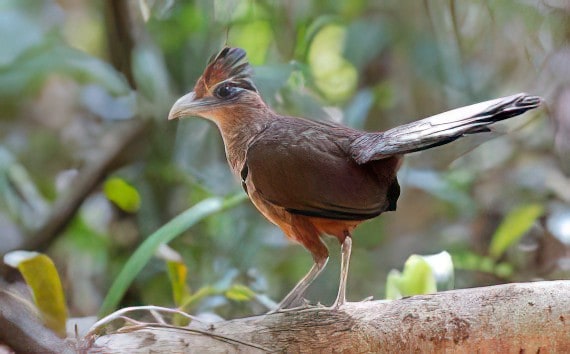Although I’m a big fan of birds, I think I fall short of being a birder. I don’t don one of those floppy wide-brimmed hats with the flap in the back and string around my neck, and I don’t own one of those scopes that you put on the tripod to spot distant birds. I think without those items, I fall short of the official birder level, but if I were a real birder, I would be very excited about the rufous-vented ground-cuckoo.
The rufous-vented ground-cuckoo (Neomorphus geoffroyi) is known as the Cuco Hormiguero in Spanish. This bird is awesome for two main reasons. First, it just looks cool. Second, it’s extremely rare.
Some birds make you stop and take notice even while you’re just flipping through a bird book. There are the dreaded pages of a million little brown and yellow birds that are easy to skip over. Or the page of a handful of birds that all look exactly like a great kiskadee. But when you come across the rufous-vented ground-cuckoo, you stop and take notice.
It’s tall, coming in at 19 inches. It has a mohawk and blue eyeliner. It has a long tail. Its brown chest gives way to shiny purple feathers on its back. In short, it looks like a punk rock roadrunner.
The Spanish name includes the word hormiguero, which gives you a hint as to what the rufous-vented ground-cuckoo does with its time, something to do with hormigas (ants). Unlike the oso hormiguero, or anteater, this bird doesn’t eat ants. Instead it does the old cattle egret trick of letting other creatures scare it up a meal. In the case of the cattle egret, cows scare insects into fleeing and the cattle egret munches them down.
In the case of the rufous-vented ground-cuckoo, army ants move like a slow wave over the forest floor and these birds dart around grabbing the little creatures that are scurrying away from the ant horde. In this way, their diet includes insects, scorpions, centipedes, spiders, small frogs, and lizards.
Though this cuckoo can be found in a fairly large number of countries including Nicaragua, Costa Rica, Panama, and a few south American countries, it is quite rare in all of those places. In Costa Rica, its range includes the wet forests on the volcanoes of northern Guanacaste over to the Caribbean coast and most of the province of Limón. As hardcore birders can attest, it is quite difficult to see in the entirety of that range.
I personally have never seen one with my own brown eyes. I have recorded them a total of four times with my camera traps. I recorded one amidst a swarm of army ants on a mountain top near Tenorio Volcano National Park, and I recorded three more videos very recently in a project in Limón.
My new recordings include my first video in color (the forests where they live are often dark and dense, resulting black and white video footage) and my first videos of two individuals together. My excitement over these recent videos prompted this article. I’m happy to share all four video clips with you in the video below.
For all of you real birders, or simple bird fans like me, that have had the pleasure of seeing a rufous-vented ground-cuckoo, please post a comment or write a message, I’d love to hear about your experience!
About the Author
Vincent Losasso, founder of Guanacaste Wildlife Monitoring, is a biologist who works with camera traps throughout Costa Rica. Learn more about his projects on facebook or instagram. You can also email him at: vincent@guanacastewildlifemonitoring.com






